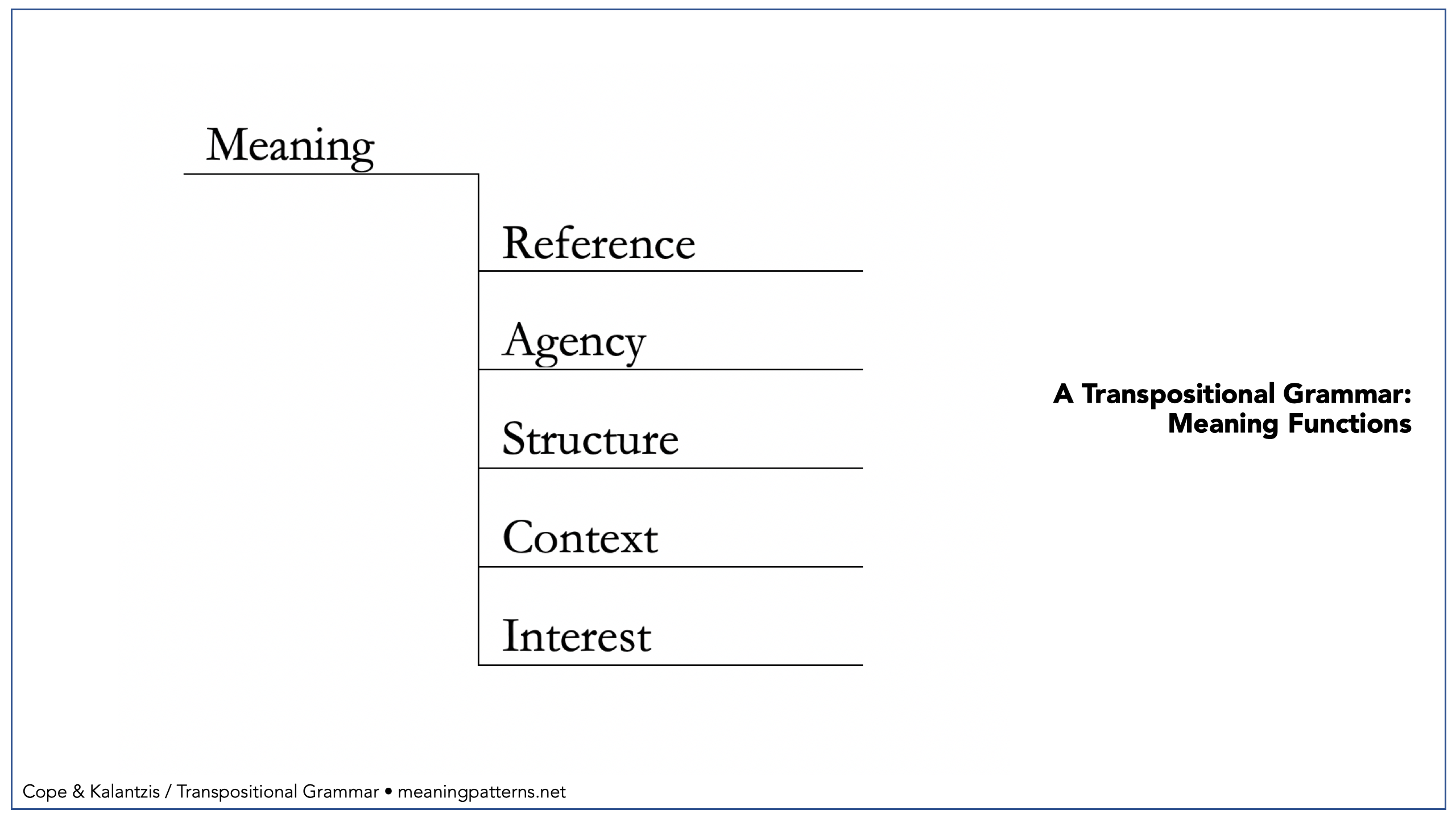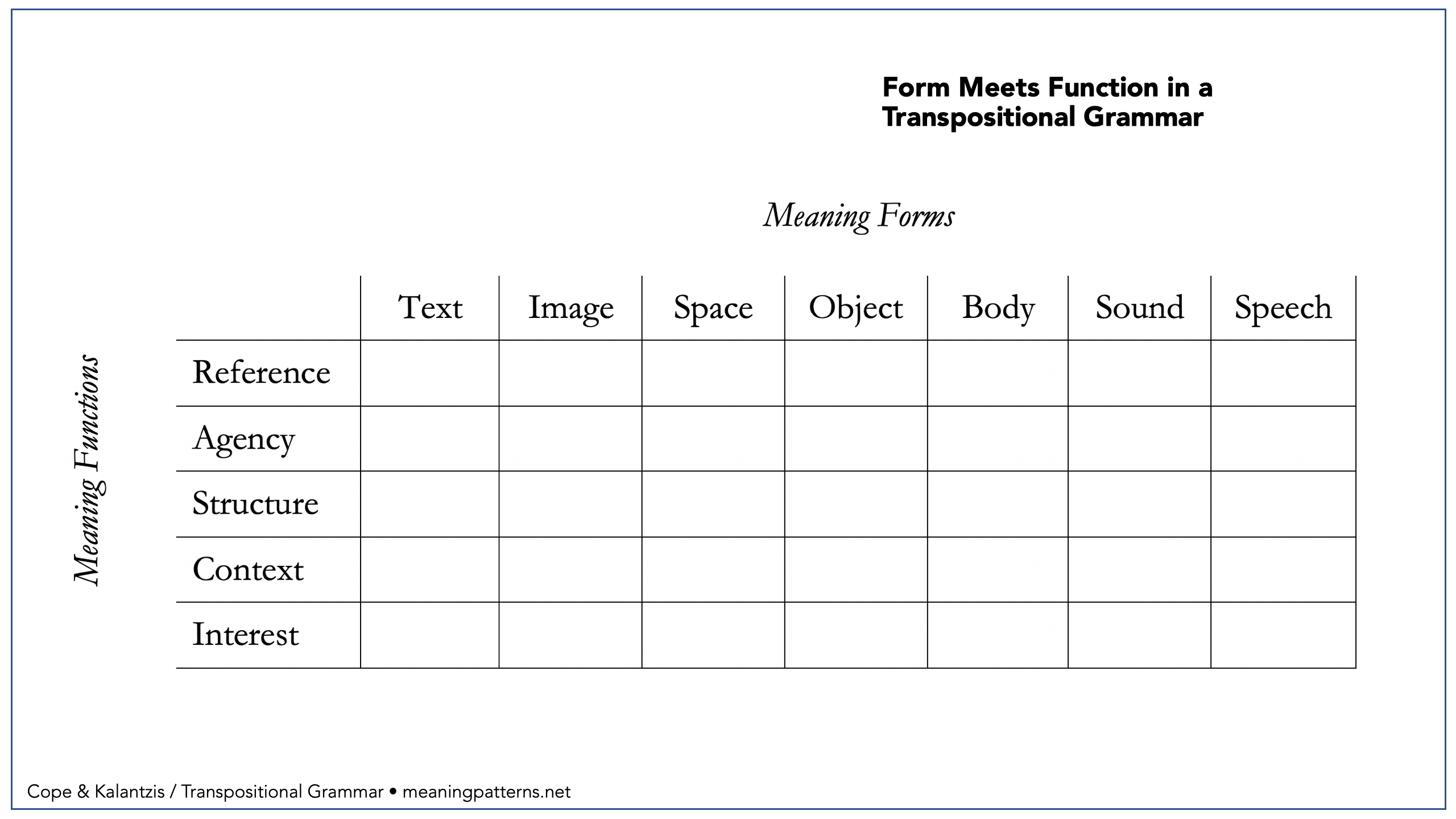On Meaning
For the purposes of a multimodal grammar, meaning is the process of making sense of the world using material media and their associated cognitive architectures; making sense of what we encounter in the natural and human-historical worlds; making sense to each other; our social and personal means of intending and acting; the patterns in these meanings and the traces they leave in the form of media artifacts; and the transpositions of meaning across different forms (text, image, space, body, sound, and speech) and within always-simultaneous functions (reference, agency, structure, context, and interest).

Participation
Making sense involves three kinds of action: representing, communicating and interpreting. These are not merely things of the mind or sign systems. They are kinds of social participation. They also require work. They use material tools and media for their work, as is the habit of our species, otherwise known as homo faber. They are things you do to mean, and the things you need to use in that meaning, in the context of shared social conditions. Participation is the making of meaning in the context of the social relations of its sharing—whether it is representation (making meanings for oneself); communication (making meanings that are accessible to others); or interpretation (making sense of meanings in the found objects of multimodal communication).
Meaning Form
Meaning takes shape through a series of actions that connect thinking with material media. Text uses writing instruments, representing phonemes and ideographs in graphemes on paper or screen. Image creates two dimensional visual meanings on canvas, or paper, or screen. Space and object create three dimensional meanings. Meanings are made in and by bodies. Sound and speech present meanings in hearable form. Meaning forms are the means by which meaning is made, the media through which representation or communication occurs, where thinking or thinkable things are expressed in text, image, space, object, body, sound, and speech.

Meaning Function
“Meaning function” refers to the uses to which meaning is put, as evidenced in the social and natural-material experience of its making, always involving reference, agency, structure, context and interest. All functions always present in every meaning. We can focus the attention of our analysis on one of these meaning functions, then another. With each shift in focus we will see different things in a meaning, perhaps complementary or conflicting. Within each meaning function there is constant movement, or functional transposition, where the momentary meaning of each function is its impatient waiting to become another. Immanent meaning embraces its imminent transposability.

Grammar
Grammar traces patterns of meaning in the forms of text, image, space, object, body, sound, and speech. Across all forms, patterns of meaning arise in the ever-present and always-simultaneous functions of reference, agency, structure, context, and interest. Grammar is the activity of parsing these patterns, making sense of their meanings. When we parse, we uncover designs. Grammar is the process of identifying and naming patterns in meaning. So, we move away from a narrow definition of grammar as syntax. In text and speech, the patterns of syntax are not separable from the patterns of lexis, semantics, and pragmatics. Text and speech are almost invariably layered into larger patterns of meaning involving also image, space, object, body, and sound. Across all these forms, there are shared patterns of meaning that we call meaning functions. And for that matter, the grammars of text and speech are as different from each other as they are from image, space, object, body, and sound. This is why we stretch the meaning of the word “grammar” beyond its conventionally narrower meanings.

References: Cope, Bill and Mary Kalantzis, 2020, Making Sense: Reference, Agency and Structure in a Grammar of Multimodal Meaning, Cambridge UK: Cambridge University Press, pp. 1-6.
Kalantzis, Mary and Bill Cope, 2020, Adding Sense: Context and Interest in a Grammar of Multimodal Meaning, Cambridge UK: Cambridge University Press, pp. 1-19.
